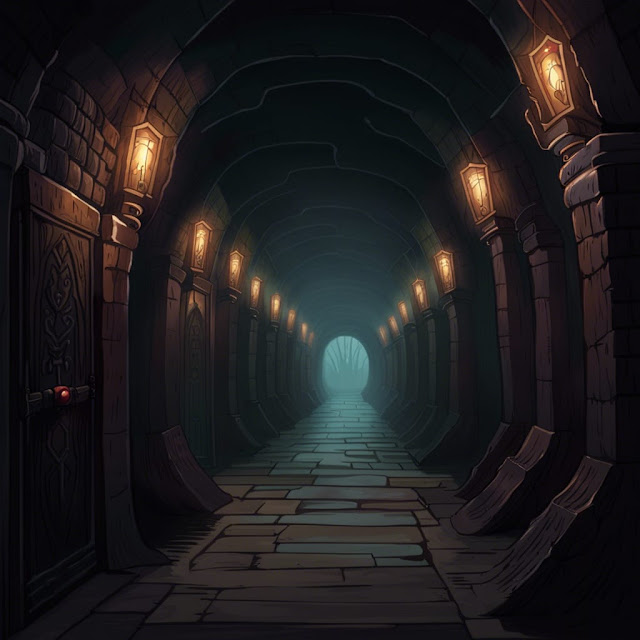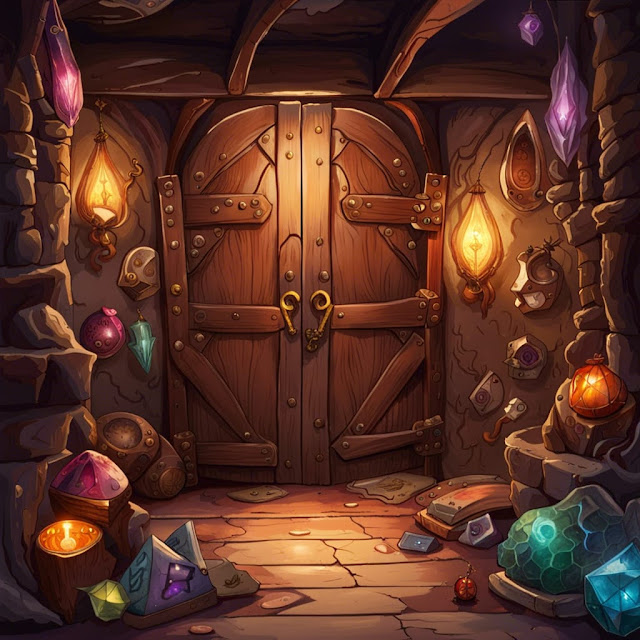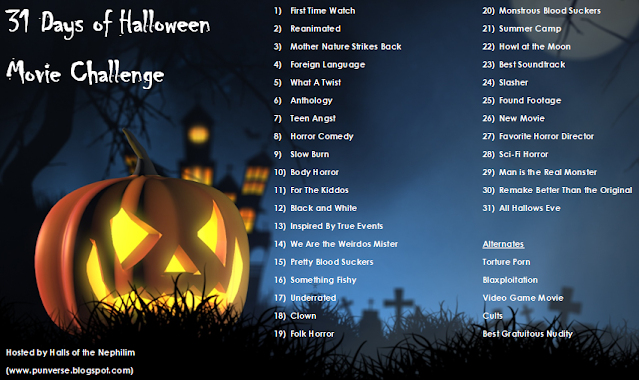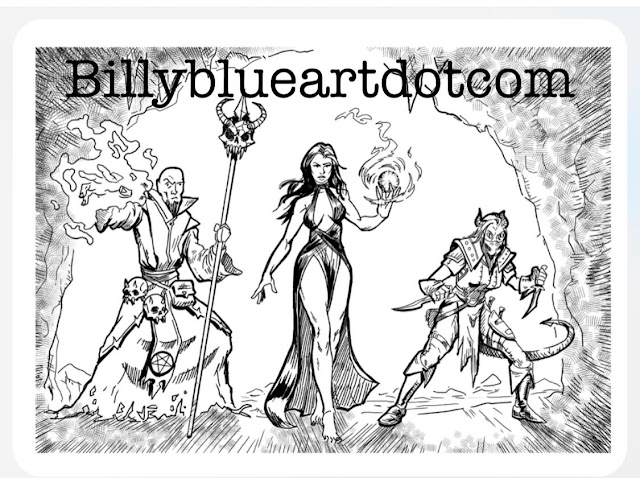What Lies Below
 If there is revolution and repression above, there is freedom below. Freedom to be who you are. Freedom of expression. Except freedom from desire. Except freedom from your heart’s desire. Or is that what your desire from the Heart… or the Heart desires from you? No-one knows what the Heart is—inquisitive god-cocoon, time-travelling alien terraformer, unknowable world-engine, the land of the dead, the root of all magic, faith, and the occult across the world, or the manifestation of all the sins committed and considered in the Spire far above. In the mile-high tower of the Spire, the Aelfir—the High Elves—enjoy lives of extreme luxury, waited upon by the Destra—the Drow—whom they have subjugated and continue to oppress the criminal revolutionaries that would rise up and overthrow through them. In the City Beneath, where heretical churches have found the freedom to worship their forbidden gods and organised crime to operate the drug farms that supply the needs of the Spire above, the Aelfir find themselves free of conformity, the Destra free of repression. They are joined by Gnolls and Humans. The former are hyena-headed people from the far south, renowned for their demonology-driven mechanoccultism technology, those in the City Beneath free to be close to the Spire despite the cold war between the Aelfir and the Gnolls. The latter are renowned for their interest in the past, retro-engineers and tomb robbers who have developed their rediscovered technology into an arms industry, those in the City Beneath, free to delve and explore as is their wont. Some simply live in the City Beneath, but others are Delvers, driven to survive and delve deep below the Spire and the City Beneath. Here they will the remnants of the Vermissian, the great public transport network that would have bound the Spire and the City Beneath together. Then caves and tunnels, first of stone and rock, then of bone and teeth. The archaeological remainders of lost civilisations. Pockets where science and the occult are what they once were or are somewhere else. Realms lit by the stars of another world. Lost worlds home to mythic predators. The closer the delver gets to the Heart, the more the unreal the City Beneath becomes… In between are landmarks, perhaps points in the darkness where sanctuary can be found, more likely danger and death, but they are always stable points by which delvers can navigate ever closer to the Heart, a “rip in the holes between worlds”, and what drives them deeper…
If there is revolution and repression above, there is freedom below. Freedom to be who you are. Freedom of expression. Except freedom from desire. Except freedom from your heart’s desire. Or is that what your desire from the Heart… or the Heart desires from you? No-one knows what the Heart is—inquisitive god-cocoon, time-travelling alien terraformer, unknowable world-engine, the land of the dead, the root of all magic, faith, and the occult across the world, or the manifestation of all the sins committed and considered in the Spire far above. In the mile-high tower of the Spire, the Aelfir—the High Elves—enjoy lives of extreme luxury, waited upon by the Destra—the Drow—whom they have subjugated and continue to oppress the criminal revolutionaries that would rise up and overthrow through them. In the City Beneath, where heretical churches have found the freedom to worship their forbidden gods and organised crime to operate the drug farms that supply the needs of the Spire above, the Aelfir find themselves free of conformity, the Destra free of repression. They are joined by Gnolls and Humans. The former are hyena-headed people from the far south, renowned for their demonology-driven mechanoccultism technology, those in the City Beneath free to be close to the Spire despite the cold war between the Aelfir and the Gnolls. The latter are renowned for their interest in the past, retro-engineers and tomb robbers who have developed their rediscovered technology into an arms industry, those in the City Beneath, free to delve and explore as is their wont. Some simply live in the City Beneath, but others are Delvers, driven to survive and delve deep below the Spire and the City Beneath. Here they will the remnants of the Vermissian, the great public transport network that would have bound the Spire and the City Beneath together. Then caves and tunnels, first of stone and rock, then of bone and teeth. The archaeological remainders of lost civilisations. Pockets where science and the occult are what they once were or are somewhere else. Realms lit by the stars of another world. Lost worlds home to mythic predators. The closer the delver gets to the Heart, the more the unreal the City Beneath becomes… In between are landmarks, perhaps points in the darkness where sanctuary can be found, more likely danger and death, but they are always stable points by which delvers can navigate ever closer to the Heart, a “rip in the holes between worlds”, and what drives them deeper…This is the setting for Heart: The City Beneath, a roleplaying game that explores the horror, tragedies, and consequences of delving too deep into dungeons. Published by Rowan, Rook, and Decard Ltd. following a successful Kickstarter campaign, it would win multiple Ennie awards in 2012, including for Best Writing, Best Setting, and Best Layout. It is both a sequel and a companion roleplaying game to the publisher’s Spire: The City Must Fall. If Spire is punk anarchy and revolution, Heart is the wild frontier and a desire to know what is out there, if that is, the wild frontier is the equivalent of a mega-dungeon and the desire to know what is out there, is the yearning to know what calls to you far below. As a dungeon-delving roleplaying game, it puts the desires and wants of the Player Characters first and foremost, shifting from the simulationist play style of the dungeon-delving roleplaying game to a narrative play style, focusing on story, and the repercussions of the Player Character actions with the Game Master expected to undertake a minimal approach to preparation beyond a location—or Landmark—or two and the elements of their characters that the players want to explore. This shift does not mean that there is any less scope for action and heroism, but rather there is more freedom to interpret and describe how it happens. Although Heart has the feel of a mega-dungeon, or at least, a dungeon frontier, it is really designed to played in short campaigns, roughly ten sessions or so. This does not mean that Heart: The City Beneath is a ‘one-and-done’ roleplaying game, that is, once the Game Master and her players and their characters have delved deep into its bowels, everything that it offers has been played. Heart: The City Beneath offers numerous options within the types of Player Characters it includes and numerous sample Landmarks, as well as a handful of campaign ideas beyond the simple delve, that give it a high replay factor.
A Player Character in Heart: The City Beneath has an Ancestry, a Calling, and a Class. Together, these will determine his Skills, Domains, and Knacks, as well as Abilities. He also has Resistances. Ancestry—either Aelfir, Drow, Gnoll, or Human—does not provide any mechanical benefit, but suggests backgrounds and reasons why the Player Character is in the City Beneath, along with trinkets he has with him. A Calling, either Adventure, Enlightenment, Forced, Heartsong, or Penitent, develops the reason further. The Adventure indicates that the Player Character is looking for excitement, Enlightenment for secrets and answers, Forced that the Player Character is not in the City Beneath by choice, Heartsong that he is somehow connected to the Heart, and Penitent that he is making amends for betraying the trust of the organisation he belongs to. Each Calling gives a Core Ability, some questions to answer that explain why the Player Character is in the City Beneath, and a list of Beats to choose from. These consist of Minor, Major, and Zenith Beats, and the higher the tier of the Beat selected, the longer it takes to complete. A beat is used to signal to the Game Master what the player would like to see his character do in the next session or so. For example, a Minor Beat for the Adventure Calling could be ‘Defeat a powerful foe one-on-one’ or ‘Kick someone off a tall structure (they really deserved it)’. Of course, this forewarns the player as to what could happen in the forthcoming session and the Game Master is going to be enabling it, but not only does completing it grant the Player Character an Advancement within his Class, but it also gives the player a roleplaying and storytelling opportunity in both anticipating and completing it!
Heart: The City Beneath has nine Classes. Each provides a Resource, some equipment, and two core abilities as well as a list of Minor, Major, and Zenith Abilities. A Player Character will begin player with three Minor Abilities and a Major Ability, and will earn more through fulfilling the Beats from his Calling. Zenith Abilities mark the Player Character’s apotheosis, and their use the end of the Player Character’s story when used as they transform the City Beneath around him. The Cleaver is a hunter whose body warps in reaction to wilderness beyond the City Beneath and consume his prey to fuel his untamed powers. The Deadwalker is caught between life and death, having already died once, is never alone from that first death, and can walk between the worlds of the living and the dead. The Deep Apiarist has become a living hive for bees and together, they help him manipulate the magics of chaos and order. The Heretic is a member of the Church of the Moon, driven out of the city Above when the Aelfir first invaded. The Hound is a mercenary who draws upon the reputation and will of a lost regiment which was sent to a pacify the Heart sometime in the past. The Incarnadine was driven into debt so catastrophically deep that Incarne, the Crimson God of Debt, marked as her own, still paying off the debt, but drawing on its divine power too. The Junk Mage is a pioneering wizard who has become addicted to the dreams and thoughts of the godlike things slumbering in the City Beneath and is driven near to madness by both the knowing and the wanting to know. Wearing unique suits of armour scavenged from the wrecks of trains leftover from the creation of the Vermissian, the Vermissian Knight guards and patrol the transport network, as well as explore the routes the network takes deeper into the City Beneath. The Witch carries a blood disease, each of a different lineage, but all from the heart itself, and uses both blood and disease in ways feared and loved.
A Player Character will have Skills, Domains, Knacks, and Resistances. The skills are Compel, Delve, Discern, Endure, Evade, Hunt, Kill, Mend, and Sneak. The eight Domains, which represent experience of an environment or a knowledge of some kind, are Cursed, Desolate, Occult, Religion, Technology, Warren, and Wild. A Player Character either has a Skill or a Domain, or he does not, but if he has a Skill or Domain twice, it becomes a Knack, which means he can roll with Mastery. There are five Resistances—Blood, Echo (representing warping influence on body and mind of the Heart), Mind, Fortune, and Supplies—and these track the amount of Stress the Player Character is suffering in that aspect. Suffer too much Stress and there is the chance of Fallout, consequences which can have temporary or permanent effect on the Player Character.
To create a character, a player selects an Ancestry, a Calling, and a Class. He answers the questions posed by each and then from each Class selects three Minor Abilities and one Major Ability. Our sample character is Redeye. She was a healer serving in the Gnollish military captured by the Aelfir of the Spire. Escaping into the City below following a prison breakout, she fell ill, thinking she was going to die… Then she heard a song and when she awoke knew it was her blood infected. Now it sings to her. She misses being under the moon and being to run under the stars. She dreams of the moon running with blood and believes that the Heart is strongest where diseases touches—for good or ill. Her fellow delver, Urwain, a Vermissian Knight recently recovered from Gnollish Scrofula, which is known to kill a human, so she thinks him strong enough to lead him to the heart. When she blinks, her eyes turn blood red, but then drain back to her normal colour.
Redeye
Ancestry: Gnoll Calling Heartsong Class Witch
Skills: Compel, Discern, Kill, Mend
Domains: Occult
Abilities: Crucible, True Form, The Old Blood, Witch-Spit, Heart-Wise, Crimson Mirror
Resistances: Blood, Echo (Protection +1), Mind, Fortune, and Supplies
Resource: Tattered Finery (D6 haven)
Equipment: Spyglass built by her lover, painted dog skull, ink-blotted dream journal with maps of the places seen in your dreams, Sacred Blade (Kill D6, Bloodbound)
Beats: Let your curiosity lead you into danger, terrify or intrigue an NPC with your obsession.
Mechanically, Heart: The City Beneath uses dice pools of ten-sided dice. Whenever a character wants to undertake an action, his player rolls a ten-sided die. To this, he can add another die for a relevant Skill, relevant, Domain, and Mastery—the lack from a Knack. Once the dice have been rolled, the player removes the highest die if the task is Risky, two if it is Dangerous. The highest die is counted. The result ranges from Critical failure to Critical success, and the Player Character can fail and suffer Stress, succeed and suffer Stress, succeed without Stress, succeed dramatically and increase the Stress inflicted on an NPC or opponent. The amount of Stress suffered by either the Player Character or opponent will vary. It can be from an Ability, a weapon, the environment, or generally how close the Player Character to the Heart. This is measured by Tier, and the higher the Tier, the closer to the Heart and the greater the Stress die rolled. Stress is marked off against the appropriate Resistance and at the end of situation, the Game Master rolls to see if the Player Character suffers Fallout, which the actual consequences of the Stress, which itself only has a narrative effective. For example, a Minor Blood Fallout could be Bleeding or Spitting Teeth, but Minor Echo Fallout could be Buboes on the skin or a Strange Appetite. Blood, Mind, and Supplies Stress is easier to remove than Echo or Fortune. NPCs only have the one Resistance, also called Resistance, meaning there is less mechanical complexity and nuance to them, leaving the Game Master and her players to narrate the effects of Stress and then Fallout upon them.
Combat in Heart: The City Beneath uses the same mechanics. It primarily uses a combination of the Kill skill plus the Domain where the fight is taking place and Blood as the primary Resistance used. This will vary depending on the situation. Notably, it only has optional rules for initiative, included if the players are used to turn-based combat. Instead, combat, including initiative, is handled on narrative basis, as in, does this narratively make sense? Combat in Heart: The City Beneath runs to a single page and even that is impressively comprehensive for a narrative roleplaying game!
Beyond the rules, there is excellent advice for running Heart: The City Beneath, whether as your first roleplaying game, your first storytelling game, or simply the first time running Heart: The City Beneath. The specific advice includes the fact that the Player Characters can change the world, that the Game Master need no longer plan, drop the idea of balanced encounters because no fight is ever fair—though here is some advice if the fight is too hard (or too easy), she should ask questions of the players and give them and their characters what they want—typically tailored to each Calling with the Beats, and so on. It handles the adjustment to the storytelling style fairly well, though it often feels as if it wants to scream out, “Yes, we know you’ve played Dungeons & Dragons. This is like that, but different, and really intense, okay?”
Two fifths of Heart: The City Beneath is devoted to describing the nature of the City Beneath. Although it discusses the main society to be found near the surface, its main focus are the Delves that the Player Characters or Delvers will be undertaking. A Delve consists of a journey between two or more Landmarks, in general the deeper the Delve, from Tier 0 down to Tier 3 and beyond. A Delve has its own route, a Tier, one or more Domains, its own Stress that will be suffered if a Player Character fails an action whilst there, possible events that can occur there, and a Resistance which must be worn down via collective action upon the part of the Player Characters. This typically means using equipment, such as rope to climb down cliffs and crevasses, a compass marked with a fifth cardinal direction—‘H’, a crowbar, and so on. The nearest equivalent are the journey rules in The One Ring: Roleplaying in the World of Lord of the Rings and Forbidden Lands – Raiders & Rogues in a Cursed World and they are tough. There is even the possibility that the Player Characters suffer so much Stress and subsequent Fallout that it is not actually worth continuing on the Delve. Some Abilities and having the right equipment can alleviate that, but it may be less frustrating for the players if Delves are handled in this fashion when it is narratively important. Perhaps if the Player Characters have used part of a Delve before, to have them learned its dangers, and so be better prepared? In that way, their experience comes into play and deeper Delves can still be dangerous.
A Landmark has a Domain, a Tier, it can be a Haunt where resources can be exchanged to remove Stress or downgrade Fallout, but it will have its own Stress that will be suffered if a Player Character fails an action whilst there, resources to be found, harvested, or stolen, and potential plots to involve the Player Characters. Heart: The City Beneath describes some forty or so Landmarks, starting with Derelictus, the City Between, the link on Tier 0 between the City Above and the City Below, followed by the God of Corpses, worshipped via its Seven Sacred Ailments which the physickers are more interested in than the patients and which a sect wants to see resurrected; Redcap Grove, a stain of fungal growth over the ruins of a cathedral, home to criminally mad druids from it is possible to purchase hallucinogens; Grin Station, a decrepit folly of an amusement park, which seems to be regenerating; and the Hoard, a vast, predatory library that seeks out books and knowledge, its librarians under the mind control of a maggoty dragon larvae at its centre. Beyond the Landmarks, there are Fractures, including Eight Heavens—each a different afterlife, and time and space seeming to bend this way and that, until finally, there is the Heart itself. If the Player Characters can reach it… There are numerous suggestions as to what the Heart is, all of them true, all of them false. Getting there though, seems beside the point. The journey seems to matter more, and the Landmarks are all brilliant and the Game Master is going to want to use all of them! Fortunately, she need not do so. Heart: The City Beneath suggests mapping the locations of the Landmarks out on a superhex of hexes roughly seven or eight hexes across. Each ring of hexes out from the centre represents a higher Tier, the hexes being populated through play as the Player Characters extend themselves out in Delves. It is very unlikely that a single play through of Heart: The City Beneath would use all of the given Landmarks and many are worth using more than once, as the various monstrous and legendary creatures given in the bestiary. Thus, whether the Game Master is running Heart: The City Beneath as one-shot Delve, a standard Delve campaign, or perhaps having the Player Characters operating or defending a haven, there is still plenty of content for the Game Master to use.
Physically, Heart: The City Beneath is stunning. The book is well written and well presented, but Felix Miall’s artwork really brings the dark, desperate feel of the City Beneath to life, often bruised and bloody, if not brooding, and if you look for it—just like the Player Characters—also wondrous and wonderful.
Heart: The City Beneath is the antidote to the dungeon-delving roleplaying game, to the first style of roleplaying game we knew. It provides a nonet of fascinating Player Character options that twist and change who we expect to be dungeon-delving and maps their progress through what they want and what their players want to see told as part of their story. They are desperate despite the danger, heedless of the horror, careless as to the consequences, and despite the grim dark nature of the City Beneath, they are heroes—at least in their own eyes. Heart: The City Beneath brings a fantastically decrepit and dangerous world to life and lets the players and their characters drive their delving ever deeper, hoping for divine divulgement, more likely to their doom, but always intense and dramatic from start to finish.





















